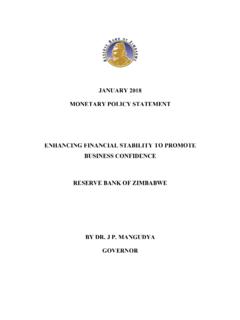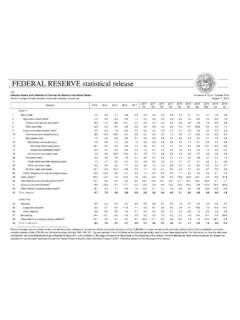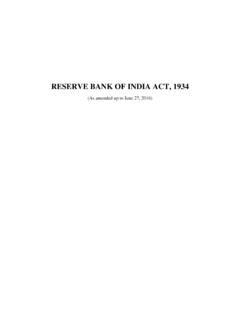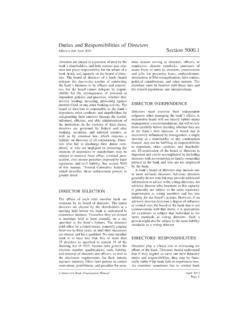Transcription of A Workbook on Bank Reserves and Deposit Expansion
1 modern money mechanics . A Workbook on bank Reserves and Deposit Expansion Federal reserve bank of Chicago This complete booklet is was originally produced and distributed free by: Public Information Center Federal reserve bank of Chicago P. O. Box 834. Chicago, IL 60690-0834. telephone: 312 322 5111. But it is now out of print. Photo copies can be made available by Introduction The purpose of this booklet is to describe the basic process of money creation in a "fractional reserve " banking system. The approach taken illustrates the changes in bank balance sheets that occur when deposits in banks change as a result of monetary action by the Federal reserve System - the central bank of the United States.
2 The relationships shown are based on simplifying assumptions. For the sake of simplicity, the relationships are shown as if they were mechanical, but they are not, as is described later in the booklet. Thus, they should not be interpreted to imply a close and predictable relationship between a specific central bank transaction and the quantity of money . The introductory pages contain a brief general description of the characteristics of money and how the money system works. The illustrations in the following two sections describe two processes: first, how bank deposits expand or contract in response to changes in the amount of Reserves supplied by the central bank ; and second, how those Reserves are affected by both Federal reserve actions and other factors.
3 A final section deals with some of the elements that modify, at least in the short run, the simple mechanical relationship between bank Reserves and Deposit money . money is such a routine part of everyday living that its existence and acceptance ordinarily are taken for granted. A user may sense that money must come into being either automatically as a result of economic activity or as an outgrowth of some government operation. But just how this happens all too often remains a mystery. What is money ? If money is viewed simply as a tool used to facilitate transactions, only those media that are readily accepted in exchange for goods, services, and other assets need to be considered.
4 Many things - from stones to baseball cards - have served this monetary function through the ages. Today, in the United States, money used in transactions is mainly of three kinds - currency (paper money and coins in the pockets and purses of the public); demand deposits (non-interest bearing checking accounts in banks); and other checkable deposits, such as negotiable order of withdrawal (NOW) accounts, at all depository institutions, including commercial and savings banks, savings and loan associations, and credit unions. Travelers checks also are included in the definition of transactions money . Since $1 in currency and $1 in checkable deposits are freely convertible into each other and both can be used directly for expenditures, they are money in equal degree.
5 However, only the cash and balances held by the nonbank public are counted in the money supply. Deposits of the Treasury, depository institutions, foreign banks and official institutions, as well as vault cash in depository institutions are excluded. This transactions concept of money is the one designated as M1 in the Federal reserve 's money stock statistics. Broader concepts of money (M2 and M3) include M1. as well as certain other financial assets (such as savings and time deposits at depository institutions and shares in money market mutual funds) which are relatively liquid but believed to represent principally investments to their holders rather than media of exchange.
6 While funds can be shifted fairly easily between transaction balances and these other liquid assets, the money -creation process takes place principally through transaction accounts. In the remainder of this booklet, " money " means M1. The distribution between the currency and Deposit components of money depends largely on the preferences of the public. When a depositor cashes a check or makes a cash withdrawal through an automatic teller machine, he or she reduces the amount of deposits and increases the amount of currency held by the public. Conversely, when people have more currency than is needed, some is returned to banks in exchange for deposits.
7 While currency is used for a great variety of small transactions, most of the dollar amount of money payments in our economy are made by check or by electronic transfer between Deposit accounts. Moreover, currency is a relatively small part of the money stock. About 69 percent, or $623 billion, of the $898 billion total stock in December 1991, was in the form of transaction deposits, of which $290 billion were demand and $333 billion were other checkable deposits. What Makes money Valuable? In the United States neither paper currency nor deposits have value as commodities. Intrinsically, a dollar bill is just a piece of paper, deposits merely book entries.
8 Coins do have some intrinsic value as metal, but generally far less than their face value. What, then, makes these instruments - checks, paper money , and coins - acceptable at face value in payment of all debts and for other monetary uses? Mainly, it is the confidence people have that they will be able to exchange such money for other financial assets and for real goods and services whenever they choose to do so. money , like anything else, derives its value from its scarcity in relation to its usefulness. Commodities or services are more or less valuable because there are more or less of them relative to the amounts people want. money 's usefulness is its unique ability to command other goods and services and to permit a holder to be constantly ready to do so.
9 How much money is demanded depends on several factors, such as the total volume of transactions in the economy at any given time, the payments habits of the society, the amount of money that individuals and businesses want to keep on hand to take care of unexpected transactions, and the forgone earnings of holding financial assets in the form of money rather than some other asset. Control of the quantity of money is essential if its value is to be kept stable. money 's real value can be measured only in terms of what it will buy. Therefore, its value varies inversely with the general level of prices. Assuming a constant rate of use, if the volume of money grows more rapidly than the rate at which the output of real goods and services increases, prices will rise.
10 This will happen because there will be more money than there will be goods and services to spend it on at prevailing prices. But if, on the other hand, growth in the supply of money does not keep pace with the economy's current production, then prices will fall, the nations's labor force, factories, and other production facilities will not be fully employed, or both. Just how large the stock of money needs to be in order to handle the transactions of the economy without exerting undue influence on the price level depends on how intensively money is being used. Every transaction Deposit balance and every dollar bill is part of somebody's spendable funds at any given time, ready to move to other owners as transactions take place.





